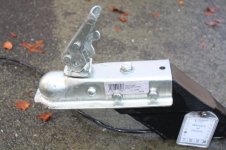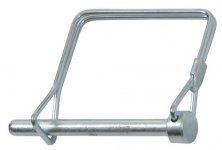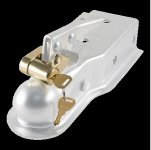Hi fellow Can Am riders. I have just built a trailer for my RT and used a Pressed Steel type coupling that appears to be exactly the same as the one used in the USA on the factory built Can Am Trailers. I however on my first trip to a Rally, I had covered 60 miles when somehow the coupling came off the towball and causing the trailer to flip. Fortunately it happened on a straight section of road and that the safety chain kept the trailer in check. As you can imagined, the trailer suffered a lot of gravel rash being dragged along the road upside down, but was able to continue on and complete the 300mile trip once I had straightened and reconnected the coupling back onto the towball. I strongly suspect that the little locking tab that clips in once the handle is engaged released thru possible vibration or sudden jarring whilst travelling (eg. hitting uneven road surface) and thus allowed the handle to release. This tab has only a soft spring to keep it in position. The tongue was engaged properly as evident by the wear marks on the towball, so I am at a loss for any other reason apart from the one fore-mentioned. I have approached the local supplier here in New Zealand and they claim that there is no fault with the design. What I find interesting that the supplier states that the coupling has an optional security hole in the handle that connects through to the connecting engagement tongue shaft and this whilst optional and not required for safe operation, can be used for added security. After my incident, I sourced a 6mm bolt which I put through this hole and was able to continue on my journey with some degree of added safety. I am still in negotiations with the supplier and they claim that they have had no reports of any problems with this coupling, so I am putting it out there to see if in fact this is true. I do find it interesting when looking a photos' on the net that a lot of the ones featured on American web pages seem to have a factory locking pin that is engaged thru the very hole that I and the New Zealand supplier has talked about.
 :sour:
:sour:
 :sour:
:sour:



 Edit Post
Edit Post